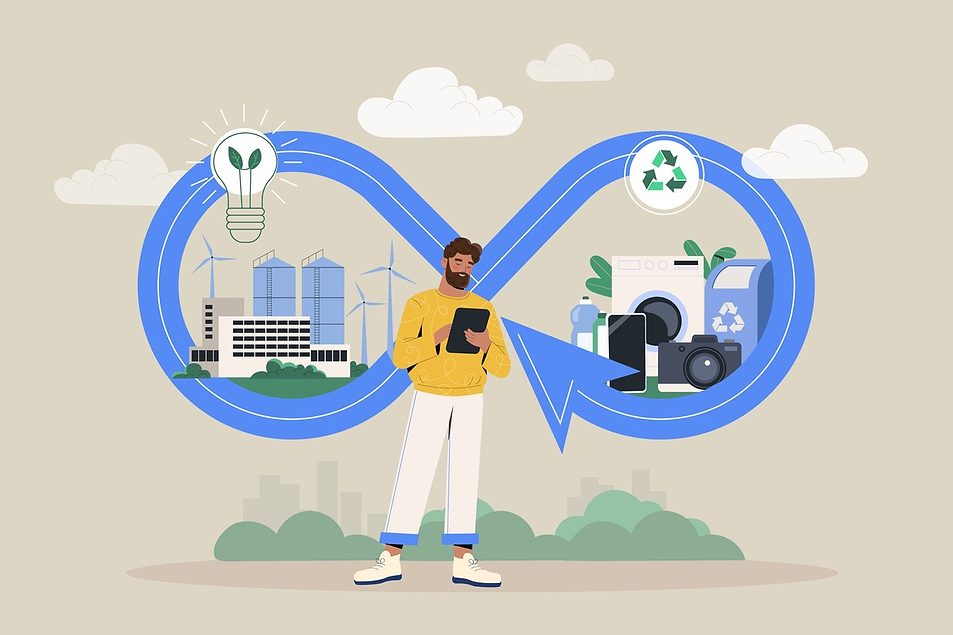
The circle of nature isn’t always reflected in the circle of consumer products, too many of which take a one-way journey to landfill.
The push for reuse and recyclability has been motivated in large part by a slew of environmental regulations, not to mention a belief that it’s for the good of the planet. Now, however, there’s a fresh incentive to promote circular supply chains: tariffs.
Thanks to the rising cost of importing goods into the U.S., what didn’t previously make sense from a business perspective — recycling comes at a steep price – is suddenly looking more attractive to manufacturers, says David Linich, sustainability principal with PwC U.S.
The Trump tariffs “are definitely increasing the input cost for organizations,” he says. Companies are looking to mitigate the impact of the new taxes by shifting sourcing to countries with lower duty levels. At the same time, they’re examining ways to reduce overall production cost — and increasingly, that entails a rethink about material origin and product lifecycles.
Having a circular supply chain means less reliance on the extraction of virgin raw materials, many of which are sourced outside the U.S. and are therefore subject to tariffs, Linich notes. By drawing on waste streams closer to home, “you’re able to repurpose and reuse for more circular business benefits.”
Such efforts, often requiring the painstaking separation of components and removal of impurities, have in the past proved prohibitively expensive. But technology — in particular, artificial intelligence and robotics — is stepping up to make that process more economically feasible.
Today’s material recovery facility, or MRF, employs cameras to visualize what’s coming across a conveyor belt, and ballistic air puffs to direct and sort materials into the appropriate areas, isolating those with the highest value and best potential for reincorporation into new products. AI-driven systems can make the proper determinations much more quickly and accurately than human sorters, Linich says.
In the case of mobile phones, sophisticated robots are enabling the rapid breakdown and disassembly of units into their component parts, freeing up precious metals at the minutest scale. Even if the phone itself can’t be refurbished or resold, “there’s still tremendous value associated with it,” Linich says.
Manufacturers are seeing additional opportunities for brand-burnishing as consumers embrace “green” products with a high degree of recyclability. In its second annual State of Decarbonization Report, PwC found a revenue upside of between 6% and 25% for products marketed with sustainability attributes, including an emphasis on repair and refurbishment. “Empirical evidence is catching the attention of more companies,” says Linich.
Against this backdrop of growing interest in supply chain sustainability, the Trump tariffs add just one more reason to pursue circularity. But the taxes of the moment, as steep and unpredictable they may be, aren’t enough to spur companies into long-term action. “Putting a more circular business model into place doesn’t happen overnight,” says Linich. “You may need to include new parties in your value chain.”
As the former division manager of a textile company, Linich remembers when it was harder to justify circularity from an economic perspective. Soliciting the return of used apparel, made easier by providing the customer with a special bag and pre-printed shipping label, was a good idea on paper. What was lacking was a partner that could turn the recycled fibers into new yarn.
At the time, the cost of employing such a service provider “didn’t pencil out,” Linich says. But if that calculation were made today, factoring in higher prices for virgin yarn sourced outside the U.S., and shoppers’ increasing willingness to pay a premium for sustainable products, it might be a different story.
“As companies game-plan how to respond to tariffs, and look to drive more resilience, circularity can serve as a tariff hedge, and make them less vulnerable to global pricing shocks,” he says.
More remains to be done to put the necessary recycling infrastructure into place. Linich says industry is currently “under-invested” in such efforts. But as countries impose new regulations, and companies find themselves subject to extended producer responsibility (EPR) laws in the U.S., they’re likely to free up funding for capturing more waste streams.
Technology can help. The growing use of lifecycle assessments (LCAs) will enable circularity at scale, allowing companies to integrate the concept at the product-design stage, and make determinations “at the click of a button,” Linich says. In the process, a manufacturer can quickly understand the tradeoff between, say, virgin and recycled copper. Digital twins — virtual depictions of the entire product-development cycle — provide a further aid.
The Trump tariffs seem to shift almost from day to day. But the push for sustainability through circular supply chains is a long-term trend, Linich says, one that’s sure to accelerate “as organizations recognize the magnitude of business value that’s on the line.”
Next: Kearney’s latest Circular Fashion Index.